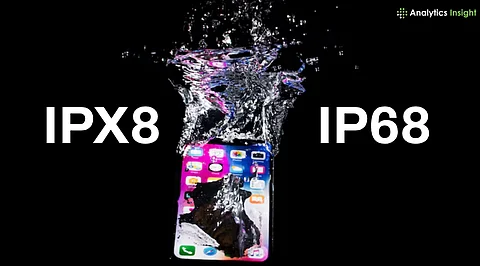

Construction workers need IP68 protection while professional swimmers perform better with IPX8 devices for maximum depth capability
Flagship phones with identical IP68 ratings show six meter versus 1.5 meter survival differences in manufacturer specifications
Pool chemicals and saltwater destroy both rating types through pathways that standard laboratory testing never evaluates properly
Water damage destroys more phones than any other factor. Tech enthusiasts and average users constantly debate IP68 vs IPX8 ratings without understanding what these numbers actually mean. Most people assume higher numbers automatically deliver better protection. This assumption costs them money and leaves gadgets vulnerable.
The difference between IP68 and IPX8 reveals surprising truths about device protection. Manufacturers make strategic choices that prioritize different safety types. Understanding these choices helps you select devices matching your lifestyle needs rather than marketing claims.
The International Protection marking system creates confusion because people misread the symbols. IP68 vs IPX8 waterproof ratings follow the same basic structure but protect against different environmental threats.
IPX8 devices focus entirely on water resistance while ignoring dust protection completely. The X means no dust testing occurred during certification. The 8 indicates continuous water immersion beyond one meter for manufacturer specified periods. Swimming earbuds often choose this rating because underwater performance matters more than dust resistance.
IP68 devices offer comprehensive environmental protection through dual certification standards. The 6 represents complete dust protection, meaning no dust particles can enter the device under any circumstances. The 8 provides identical water protection to IPX8 ratings. Construction workers and outdoor enthusiasts benefit from this combination approach.
Tech enthusiasts should recognize that identical ratings can deliver vastly different real world performance. The iPhone 16 Pro Max survives six meter depths while Samsung Galaxy S24 Ultra handles only 1.5 meters despite both carrying IP68 certifications.
Smart manufacturers choose ratings based on intended use cases rather than marketing appeal. Samsung Galaxy Z Flip series carries IPX8 because the hinge design prevents dust certification. The folding hinge design creates small openings where dust particles can enter the device.
Swimming focused devices deliberately select IPX8 ratings for maximum aquatic performance. TOZO T6 earbuds handle one meter submersion for thirty minutes minimum. H20 Audio Sonar PRO headphones survive underwater use with built in music storage.
Flagship smartphones typically choose IP68 for broad market appeal and comprehensive protection. iPhone 16 Pro Max demonstrates six meter water resistance alongside complete dust protection. OnePlus 13 pushes boundaries with IP69 certification that survives dishwasher testing.
IP68 vs IPX8 swimming performance reveals both ratings handle aquatic activities effectively. IP68 devices provide additional protection against sand and pool deck debris that often accompanies water sports.
Also Read: AirPods vs Bose: Which Brand Actually Makes Better Earbuds?
Choosing between ratings requires honest assessment of your actual device usage patterns. IPX8 vs IP68 which is better depends on whether you face specialized or general protection needs.
IPX8 excels for dedicated water activities where submersion depth and duration matter most. Professional swimmers and marine workers benefit from devices engineered specifically for aquatic environments. Underwater photographers choose IPX8 cameras because dust protection adds unnecessary complexity to waterproof designs.
IP68 serves general users who encounter diverse environmental challenges throughout normal daily routines. Construction workers face both dust and water threats that require comprehensive protection approaches. Hikers encounter trail dust, stream crossings, and sudden weather changes that challenge single protection systems.
Budget conscious consumers should recognize that IP68 certification costs manufacturers more than IPX8 due to additional testing requirements. This cost difference influences device pricing and feature combinations across product lines.
Laboratory testing conditions differ dramatically from real world usage environments. IP68 vs IPX8 waterproof testing still uses fresh water at controlled temperatures and pressures. Actual usage involves movement, temperature fluctuations, and chemical exposure that can overwhelm certified protection systems.
Swimming pools contain chlorine that corrodes seals and gaskets over time. Ocean water introduces salt that damages internal components through microscopic entry points. Hot tubs combine heat and chemicals that exceed testing parameters significantly.
Physical wear from drops, impacts, and repeated use gradually compromises waterproof integrity throughout device lifespans. Charging port covers stretch and tear with daily cable insertion. These maintenance issues affect long term protection regardless of initial certification levels.
Understanding these limitations helps establish realistic expectations and appropriate usage patterns. Water resistance provides emergency backup protection rather than invitation for risky behavior with expensive devices.
The difference between IP68 and IPX8 reflects different engineering priorities rather than universal rankings. IP68 delivers comprehensive protection while IPX8 provides specialized water resistance.
Market trends show manufacturers increasingly choosing IP68 for mainstream devices while reserving IPX8 for specialized applications. This reflects consumer preference for versatile protection.
Premium brands standardize IP68 across product lines while budget manufacturers use IPX8 to reduce costs. This creates market segmentation based on protection philosophy.
